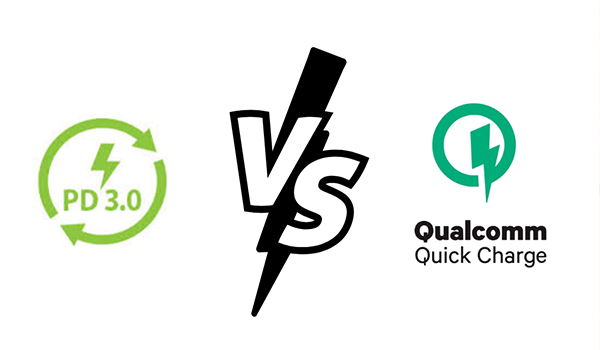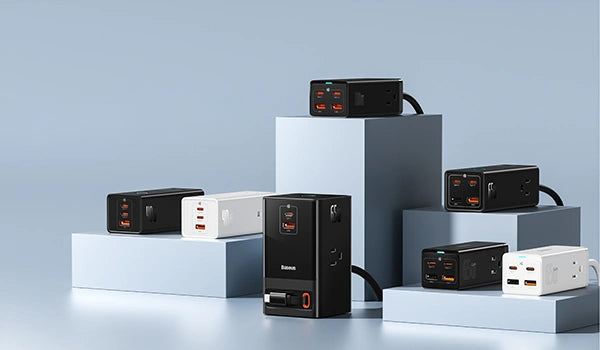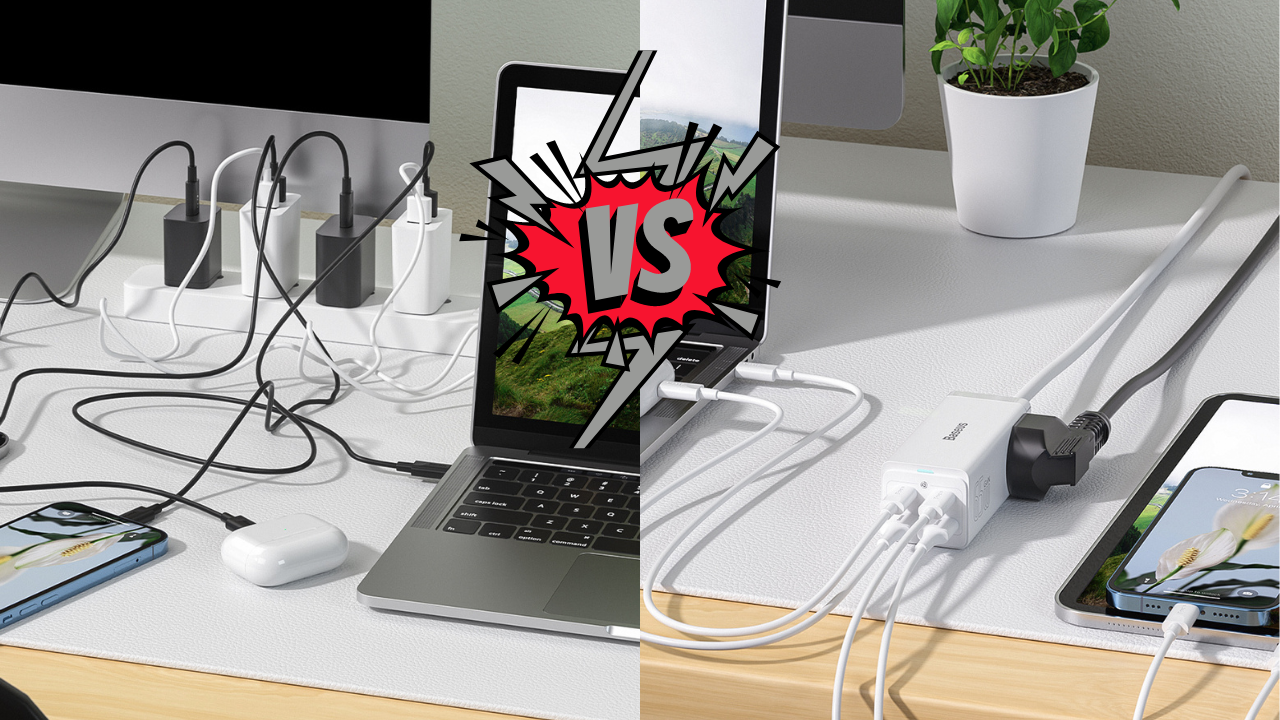Power Delivery Vs. Quick Charge: The Differences Between Fast-Charging

The need to stay powered up has become a necessity in the age of smartphones and other devices that keep us connected. We need to stay connected to the world, so we’re constantly looking for the best and fastest way to charge our devices. This scenario is where fast-charging technologies come in.
Many people are familiar with Qualcomm Quick Charge (QC) and Power Delivery (PD). But what sets them apart, and why are fast-charging technologies so important? Here, we’ll cover everything there is to know about the Qualcomm Quick Charge and Power Delivery technologies, their differences, and how they continue to evolve and progress.
What is Fast Charging Technology?
Fast charging is a popular feature in many modern devices. It allows users to power up their device in a fraction of the time it typically takes without advanced charging solutions. Fast-charging technology is divided into two common types: Qualcomm Quick Charge (QC) and Power Delivery (PD).

While both methods allow the user to charge their devices faster than before, they operate differently and with different charging levels. Understanding the differences and mechanisms of these technologies is crucial to anyone looking to purchase the best technology for personal or professional use.
How Does Fast Charging Work?
Fast-charging technologies work thanks to two manufacturing adjustments: boosting the amperage of a charge or varying its voltage to increase potential energy. Fast charging technology typically focuses on varying the voltage to increase the potential energy in a device rather than boosting the amperage.
Power is distributed to the device in three stages. The amount of power distributed and charging duration largely depend on the fast-charging standard, which is an established charging process corresponding to a specific device, charger, and power output. The three stages of charging are as follows:
- Stage one: constant current, meaning the voltage increases towards its peak while the current remains constant. In this stage, a significant amount of power is delivered to your device.
- Stage two is saturation, meaning the voltage has reached its peak, and the current begins to drop.
- Stage three: trickle/topping, meaning the batter is fully charged. In the final stage, power either slowly trickles into the device or periodically charges a low “topping” amount while the phone consumes battery power.
Types of Fast Charging Technology

Various devices have fast-charging capabilities, including the Baseus PowerMega 3 Ports Fast Charger 140W. Fast charging technology often come in one of the following forms:
- Fast-charging power banks
- Fast-charging power strips
- Fast-charging car chargers
What is QC Charging?
Qualcomm Quick Charge (QC) is a fast-charging technology developed by Qualcomm Technologies Inc. QC is designed to work with any device with a Qualcomm Snapdragon processor. QC technology delivers more power compared to a standard USB connector that charges most mobile devices.
QC charging technology elevates the voltage of a charge while avoiding overheating the USB cable. Quick Charge 5 can deliver more than 100 watts of power to its users and has numerous essential safety features to protect your devices from overheating, over-voltage, or over-current.
While QC works well with devices with a Qualcomm Snapdragon chip, it is not limited to Qualcomm devices. Any manufacturer can license QC technology from the company, which is common in many Androids, tablets, power banks, and chargers.
Qualcomm Quick Charge technology has charging speeds of up to 0-50% within five minutes of charging and supports 250+ mobile devices and 1000+ accessories, making it an incredibly versatile solution for those seeking fast-charging technology.
Variations of Qualcomm Quick Charge Technology
There are various versions of QC technology, and the software has evolved over the years to suit the needs of its users better. Below is a breakdown of the primary QC versions: Qualcomm Quick Charge 1.0, Qualcomm Quick Charge 2.0, Qualcomm Quick Charge 3.0, and Qualcomm Quick Charge 5.0.
Qualcomm Quick Charge 1.0
When used with devices like phones, Qualcomm Quick Charge 1.0 can charge a device up to 40% faster than phones predating this technology in 2013. At the time of its release, QC 1.0 was unique for its ability to bring phones to full charge in three hours or less, compared to previous technologies that took over four hours for plugged-in charging.
Qualcomm Quick Charge 1.0 worked with many first-generation smartphones, such as Android’s Moto X.
Qualcomm Quick Charge 2.0
Introduced in 2014, Qualcomm Quick Charge 2.0 technology is connector-independent, scalable across different classes of technology, and works with USB Type-A, USB micro, USB Type-C, and various proprietary connectors.
The QC 2.0 technology differentiates itself from conventional USB methods because it is an end-to-end solution that takes advantage of high power levels to charge devices efficiently. Upon its release, Quick Charge 12.0 provided:
- Up to 24 watts over a micro USB connector for QC 2.0 Class A
- 36 watts with a Type-C connector for QC 2.0 Class A
- 60 watts or more for Class B
Qualcomm Quick Charge 3.0
The QC 3.0 technology, introduced in 2015, improved upon its predecessors significantly. Quick Charge 3.0 could refuel devices four times faster than traditional charging methods and charge twice as fast as QC 1.0 while being 38 percent more efficient than QC 2.0.
QC 3.0 technology employs Intelligent Negotiation for Optimum Voltage, an algorithm that enables optimum power transfer abilities. Qualcomm’s Quick Charge 3.0 technology supports various voltage options compared to versions 1.0 and 2.0 and contains a more granular voltage range: 200mV increments, from 3.6V to 20V.
Additionally, QC 3.0 supported a more comprehensive array of connectors, such as USB Type-A, USB micro, USB Type-C, and proprietary connectors.
Qualcomm Quick Charge 5.0
Introduced in 2020, the latest version of QC technology delivers fast speeds, making it the fastest commercial charging option for Android devices. Qualcomm Quick Charge 5.0 improved upon previous versions of QC technology through numerous efficiency improvements and new battery technology, accessories, and safety features.

Qualcomm Quick Charge 5 supports over 100 watts of charging power in smartphones and can bring a user’s phone charge from 0 to 50 percent in as little as five minutes. Below are some highlights of QC 5.0 charging technology:
- Safety features: eight levels of voltage protection, three levels of current protection, three levels of thermal protection, and three levels of timer protection, along with USB-input overvoltage protection at 25V and extreme power controls over 30V.
- Efficiency features: Charges smartphones and compatible devices up to 10 degrees Celsius cooler than other chargers and is up to 4 times faster and 70 percent more efficient than other options.
- Ecosystem features: QC 5.0 enables a single accessory to address various charging implementations in mobile devices and supports more than 250+ mobile devices.

What is PD Charging?
USB power delivery (PD) is a fast-charging technology standard in some iOS and Android devices. This method delivers higher power levels compared to standard charging. USB-C power delivery technology can deliver up to 100 watts of power to a device, making it helpful for larger devices but overpowering for some smaller devices.
PD technology was developed by the USB-IF Association and used the latest USB-C interface. All devices that implement PD fast charging are charged with a USB-C port, making it unsuitable for individuals operating with the traditional USB-A port.
Power Delivery 3.0
USB PD 3.0 charging solution allows for power delivery of up to 100 watts through a single cable and can power multiple devices simultaneously. Power Delivery 3.0 eliminated the need for AC adapters for a user’s multiple devices and included two helpful features:
- Fast Role Swap features allow devices to switch roles between power provider and consumer
- Programmable Power Supply to allow rapid charging solutions without overheating devices
PD Vs. QC: What are the Main Differences?
Now that you know the essential factors of QC and PD fast charging, look at the breakdown below of PD vs. QC technologies and the primary differences between power delivery and Qualcomm Quick Charge solutions.
- PD requires higher voltage and current to charge a device than QC technology, which is helpful for devices with significant power demand.
- Most smartphones adopt Qualcomm Quick Charge over power delivery charging.
- QC technology has a commonly used voltage of 5V, 9V, or 12V, while PD technology has commonly used voltages of 5V, 9V, 12V, 15V, or 20V
- QC technology has a commonly used current of 1A or 2A, while PD technology has a commonly used current of 5A.
Baseus Chargers Can Power Your Devices Fast

Fast-charging technologies have come a long way since their introduction and continue to evolve and adapt to meet consumer needs. Qualcomm Quick Charge and Power Delivery technologies help power devices faster than before. Baseus chargers can power your devices faster than ever before through QC technology solutions.
The Baseus GaN2 4 Ports Fast Charger 100W integrates the GaN and Power Delivery technology, while the Baseus GaN2 USB-C Fast Charger 100W integrates the GaN and Qualcomm QC 5.0 technology. Our wide array of charging solutions is essential for any tech-savvy individual looking to optimize their charging time and use their devices more frequently and comfortably.
Our minimalist, high-quality consumer electronics can make your life simpler and your work more enjoyable. Contact our team today to learn more about the solutions that Baseus experts offer consumers.
 United States/English
United States/English






